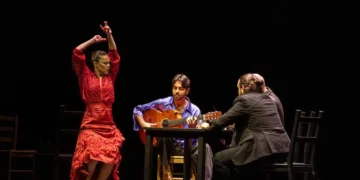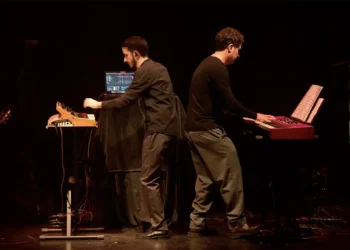|
17th Festival Flamenco Ciutat Vella Lebrijano / Somorrostro Dansa Flamenca / Carmen Linares / Marco Flores / Mayte Martín / Rocio Molina / José de la Tomasa / Fraskito. CCCB – May 19th to 22nd, 2010 – Barcelona Text: MariaJo López Vilalta Barcelona rocks with soleá, poetry and creativity Once again you could feel the force of the flamenco following that exists in Barcelona. The prestigious Festival de Flamenco Ciutat Vella filled the colorful venue of the Pati de les Dones of Barcelona’s Centre de Cultura Contemporánea (CCCB) with the full impact of flamenco distributed between the most traditional and newest tendencies the genre has to offer. The organization definitely had the right idea when they put together an eclectic program for a genre that historically overdoes orthodoxy. That’s the key to bringing in the most varied audience where there is room for purists and mere fans, flamencos and followers of other genres such as jazz or world music. In this sense, it’s surprising that in a tourist destination such as Barcelona, this festival attracts an almost totally local audience. Barcelona’s flamenco past cannot be denied, and although the most intense times are a part of the distant past – lest we forget that Barcelona was in the early 19th century the Spanish city with the most Cafés Cantantes – there is an undeniable weakness for both flamenco singing and dancing. Seventeen years at the cutting edge It seems like only yesterday when some lucky Barcelona flamenco fans received the welcome news that a festival was to be founded in the city’s gothic center. The Pati Llimona was the first venue to accommodate the idea of Lluís Cabrera, director of the Taller de Musics and of the Festival de Flamenco Ciutat Vella, the place where this original event brought several days of true flamenco workshops and master classes in history and music. That was a long time ago and the format has been coming together more and more, growing and evolving, until reaching this 17th edition. If in the early years we heard Agujetas, Rancapino and the sisters from Utrera, in recent editions the festival has thrown off its corset to offer, along with deep flamenco, fusion and experimental shows, even allowing an important place for the homegrown rumba catalana. Groundbreaking ideas One of the most surprising and unusual moments of the festival was in the hall of the CCCB and in a small corner next to the main stage of the Pati de les Dones. Tócame las Palmas y Tapeors, respectively, were the two exquisite bits served to precede the big concerts. On the one hand, under the direction of Juan Carlos Lérida, we were able to see small-scale dance shows and music by Catalonian performers or people resident in Catalonia, and no one was left unmoved. Among them, the one hundred percent female group of dancers Belén Cabanes, Montse Sánchez and Eli Ayala were noteworthy with their striking take on flamenco coexisting with dance theater offered by Sonia Sánchez and Iván Góngora on Friday the 21st. As far as Tapeos, this were a total of four mini performances selected from among all the proposals that had been received, hard to categorize but absolutely apt to open minds and show that flamenco is compatible with limitless risk-taking and creativity. From a choral all-woman show that brought together soul and pseudo flamenco, to predominantly theatrical proposals. A pleasant gift without great pretensions for a very specific audience, which had a place for young artists who experiment with flamenco-based elements. The royalty of the festival
The other royalty of the festival was the infallible Carmen Linares. Portly, stately and elegant, the audience was with her every step of the way. The concert was divided in two parts. The first was given over to the most traditional cantes, accompanied by the solid guitar of Salvador Gutiérrez. In the second part the woman from Linares brought in a youthful touch presenting guitarists Eduardo Pacheco and Pedro Barragán, two young men who gave everything in their accompaniment with songs from Federico García Lorca, Juan Ramón Jiménez, Antonio Machado, and of course, the poet being honored in this festival, Miguel Hernández. Songs based on soleá, toná, bulerías and even a moving nana, “Canción de Madrid” of Juan Ramón Jiménez. Despite some problems with the sound which Linares had to solve with the technicians, they offered a night of exquisite flamenco and pure poetry that earned a standing ovation and a little dance in the fiesta finale.
The new Carmen Amaya
Moving poetry Flamenco versus Poetry was the slogan for the four days of the festival. The spirit of Lorca, Machado and especially Miguel Hernández, on the occasion of the latter’s centennial, were floating around the atmosphere in all the shows, from traditional to avant-garde. We saw the newest generation of works such as that of the first day with the company Somorrostro Dansa Flamenca. An excellent production of the Taller de Músics directed by dancers Nacho Blanco and Eli Ayala, backed up by a group of first-class musicians from the world of flamenco and jazz who offered a unique journey through the different forms of flamenco impregnated with a contemporary feel. Another show in the same vein was presented by Fraskito and his band of eight musicians with the title Tierra y Sangre. Although somewhat lacking, this show by the man from Alicante was the one that best corresponded to the tribute being offering by the festival to the poet from Orihuela.
If anything was clear from this 17th edition of the festival Flamenco Ciuta Vella, it’s that there is a promising and ample flamenco panorama ahead of us. As Carmen Linares said at one point in her performance, “we must support young people and make room for them in flamenco…hooray for youth!” And that is the heart and soul of the festival, not only in its parallel program, but in the main concerts as well. But to be a well-rounded festival, there had to be veterans from whom we must never stop drawing. In addition to the wonderful Lebrijano whom we already mentioned, on the last night the program included two veteran maestros of dance who took us straight to the heart of cante and dance. Antonia Santiago Amador, la Chana, although she was in the secondary show of Tócame las Palmas, she managed to take charge with her dance full of strength and vitality. On the way out you could hear the audience commenting on the unbelievable power of this woman’s footwork, after fifteen years without of performing. After her, “the humble singer” as he described himself, José de la Tomasa. The Seville singer interpreted alegrías de Cádiz, then got into taranto and “my people’s national anthem” which is how he describes siguiriyas. De la Tomasa managed all that and then some for the last night of the festival which he rounded out with some excellent fandangos de Huelva, leaving us with a wonderful taste of traditional flamenco. |
|
More information: |




 This year’s edition opened with a bang, although it was a short concert – it lasted considerably less than the rest – Juan Peña El Lebrijano. A good choice on the part of the organization, because this free-form maestro has no complexes and he had the audience in the palm of his hand, thanks to the quality of his cante, a great stage presence and his easy connection with the audience. For openers, his sincere praise for Catalonian culture which he claimed to admire, this was the preamble to the performance of his great heir to the gypsy-Andalusian tradition, accompanied by the superb guitar of Pedro Peña Dorantes, brother of pianist Dorantes.
This year’s edition opened with a bang, although it was a short concert – it lasted considerably less than the rest – Juan Peña El Lebrijano. A good choice on the part of the organization, because this free-form maestro has no complexes and he had the audience in the palm of his hand, thanks to the quality of his cante, a great stage presence and his easy connection with the audience. For openers, his sincere praise for Catalonian culture which he claimed to admire, this was the preamble to the performance of his great heir to the gypsy-Andalusian tradition, accompanied by the superb guitar of Pedro Peña Dorantes, brother of pianist Dorantes. One of the big sensacions of this year’s edition, was, without a doubt, Rocío Molina. After an especially brilliant performance of Mayte Martín, with the exquisite guitar of Juan Ramón Caro, singing better than ever, showing off her technical prowess in cantes modulated at will and with all the good taste that characterizes her, along came that small girl with the round form, dressed more like a pop star than a flamenca. With the Pati de les Dones filled to capacity, no one could have imagined that from that moment on we would experience one of the most splendid evenings of the festival. They say this girl is the best thing to happen to flamenco in recent years, and the most brilliant dancer to come out of Málaga in decades. She’s been dancing since the age of three, and at only thirteen she had a single performance at Barcelona’s Teatro Goya. Even then you could see the potential of this unusual dancer. The passage of time, hard work and constant learning, along with a natural gift and the urgency of her character, have now turned the young hopeful into a fine flamenco dancer, worthy of entering the annals of history. Five costume changes, five different forms, five ways of feeling dance, from a standpoint of minimalism, but with the power which inevitably evokes the earthy Carmen Amaya. Her appearance at the Flamenco Festival Ciutat Vella stirred up an audience which had been difficult to move until that point. Lluís Cabrero announced via loudspeaker that there would be an unforgettable fiesta finale: Mayte Martín, Juan Ramón Caro and Rocío. Together, they had a great rapport.
One of the big sensacions of this year’s edition, was, without a doubt, Rocío Molina. After an especially brilliant performance of Mayte Martín, with the exquisite guitar of Juan Ramón Caro, singing better than ever, showing off her technical prowess in cantes modulated at will and with all the good taste that characterizes her, along came that small girl with the round form, dressed more like a pop star than a flamenca. With the Pati de les Dones filled to capacity, no one could have imagined that from that moment on we would experience one of the most splendid evenings of the festival. They say this girl is the best thing to happen to flamenco in recent years, and the most brilliant dancer to come out of Málaga in decades. She’s been dancing since the age of three, and at only thirteen she had a single performance at Barcelona’s Teatro Goya. Even then you could see the potential of this unusual dancer. The passage of time, hard work and constant learning, along with a natural gift and the urgency of her character, have now turned the young hopeful into a fine flamenco dancer, worthy of entering the annals of history. Five costume changes, five different forms, five ways of feeling dance, from a standpoint of minimalism, but with the power which inevitably evokes the earthy Carmen Amaya. Her appearance at the Flamenco Festival Ciutat Vella stirred up an audience which had been difficult to move until that point. Lluís Cabrero announced via loudspeaker that there would be an unforgettable fiesta finale: Mayte Martín, Juan Ramón Caro and Rocío. Together, they had a great rapport.  The command of veteran artists
The command of veteran artists



















